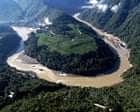
The advent of significant innovations spanning across water management and technology heralds a new era of sustainable development and healthcare efficiency. In recent developments, three stories prominently outline a trajectory toward a more harmonious and interconnected global future. These include China’s ambitious construction of the world’s largest hydropower dam, Europe’s strategic roadmap on improving water efficiency, and the implementation of artificial intelligence (AI) in healthcare to alleviate emergency services.
China has embarked on the monumental task of constructing the world’s largest hydropower dam along the Yarlung Tsangpo river in the Tibetan territory. Touted as the “project of the century,” this massive infrastructure initiative aims to meet the nation’s burgeoning energy demands while simultaneously marking China’s commitment to renewable energy sources. Set against the backdrop of international concern, particularly from downstream nations such as India and Bangladesh, this project holds the potential to redefine geopolitical relations through the prism of sustainable energy generation. Despite these challenges, China remains steadfast in advancing this 1.2 trillion yuan endeavor, promising substantial contributions to clean energy production.
Meanwhile, across the globe, the European Union is intensifying its efforts to enhance water efficiency as part of its Water Resilience Strategy. The strategy sets forth an ambitious objective to reduce water wastage by 10% across Europe by 2030, capitalizing on the necessity for innovative water management solutions in the face of climate change. This initiative aims to address the continent’s 30% water loss challenge, positioning water conservation and resource management at the forefront of policy agendas. Such measures not only align with ecological sustainability goals but also ensure a resilient ecosystem for future generations.
In the realm of healthcare, the introduction of the HUMAI platform—High Users Management with AI—marks a technological leap, leveraging AI to optimize the delivery of emergency services. The platform anticipates frequent usage patterns in emergency departments, enabling proactive measures to manage patient inflow efficiently. This foresight fosters a reduction in the pressure on critical care facilities, ensuring timely and prioritized medical attention to those in urgent need. It epitomizes the symbiotic relationship between technology and healthcare, where AI serves as a bridge to a more responsive and resilient healthcare infrastructure.
These initiatives, while distinct in sectorial focus, collectively underscore a commitment to harnessing technology and strategic planning for global advancement. They represent forward-thinking approaches to perennial challenges, where collaboration and innovation emerge as pivotal to sustainable progress. As China, Europe, and the broader global community navigate these developments, they lay down pathways for an integrated future, where renewable energy, efficient resource management, and technological empowerment become the cornerstones of a vibrant global society.
Source: {link}
